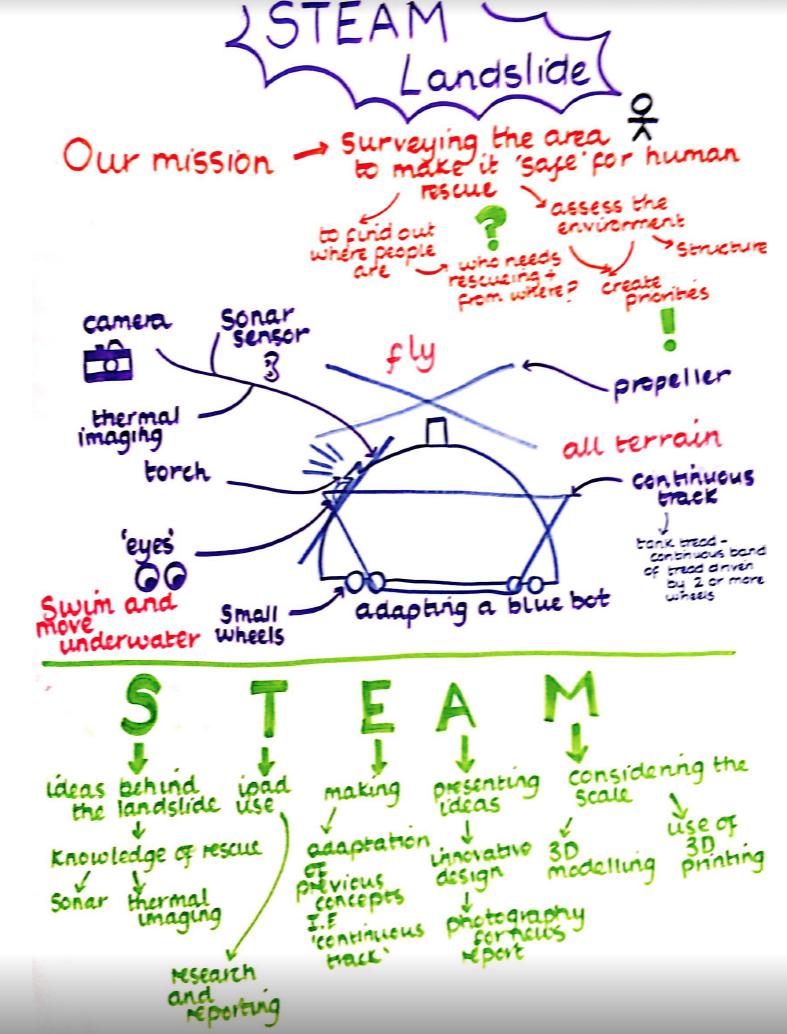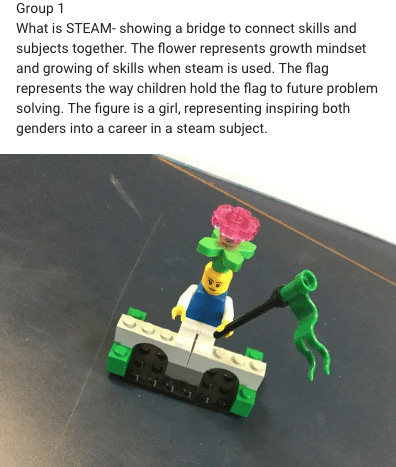As we have seen in Section 1, in its second year, the DLaB project sought to bridge traditional subject boundaries by exploring the theme of STEM to STEAM, adding the arts to science, technology, engineering and maths. This theme builds on the previous year’s theme of technology outdoors by promoting real world exploration and tangible making imbued with digital technology.
Our pedagogical approach was based on an interpretation of ‘design thinking’ (Kimbell, 2015), an approach that begins with empathising, and puts an emphasis on defining a key question and then framing a problem. This is more akin to problem finding rather than problem solving. This model was relevant, as we wanted to highlight creativity alongside the criticality of the scientific process. We used a ‘double diamond’ model to describe divergent and convergent stages of a process that aims to build up ideas through a combination of empathising, defining, ideating, prototyping and testing. Several possible ideas are created (divergent thinking) before refining and narrowing down to the best idea (convergent thinking). The double diamond indicates that this happens twice – once to discover and define the problem and secondly to develop and deliver the solution. Central to the process are three stages: a trigger, a vision and plan, and a creative solution. The role of the teacher is to steer learners’ thinking through phases of joint ideation and then bring their innovations alive through prototyping and refining ideas. In this way, design thinking draws upon logic, imagination and intuition to explore possibilities of what could be, and then creates outcomes that benefit the audience or end users. In the context of the DLaB international collaboration days, pupils moved from design thinking to design doing. Adaptation of the UK Design Council’s ‘Double Diamond’ model (https://www.ebi.ac.uk/training/online/course/user-experience-design/phases-design)
Adaptation of the UK Design Council’s ‘Double Diamond’ model (https://www.ebi.ac.uk/training/online/course/user-experience-design/phases-design)
The DLaB project has shown that the arts can offer an additional impetus to design thinking by being part of the trigger prompting learning. We also wanted to use the arts to connect with others and communicate the outcomes of the STEAM activities.
Conversely, the arts can also become the driver for communicating the results of STEM investigations. To give an example, university students participated in STEAM sessions testing rescue robots and drones in simulated disaster environments. Designated ‘makers’ customised and tested the robots and drones, ‘reporters’ devised news reports using iMovie, and ‘researchers’ recorded visual minutes to document the STEAM learning process as it unfolded. Groups reflected before and after their sessions using Lego Serious Play.




From Design Thinking to Design Doing at the University of Northampton
In this way, the arts might be enfolded into any part of the learning event, as a multimodal channel for learning, a catalyst, a mediator or a communication tool that makes the STEM aspects more accessible to others. International collaborations based on the arts in the DLaB project provided a context for intercultural exchanges supported by technology.
In the example above, the digital imagery posted in an online community helped to articulate students’ changing understanding of STEAM learning from the beginning to the end of their sessions. The fact that digital artefacts were made for an audience and were shared online meant that they could be used to build collective understanding. This suggests a role for the digital arts and mobile technologies in reframing the social construction of knowledge. These ideas sit well with the idea of humanistic knowledge-building communities noted by Ferguson et al. (2017) and Scardamalia’s system of knowledge building principles (2002). In work of this nature, technology can become a learning lens and posted visual media can represent new viewpoints that invite feedback.
References
Ferguson, R., Barzilai, S., Ben-Zvi, D., Chinn, C.A., Herodotou, C., Hod, Y., Kali, Y., Kukulska-Hulme, A., Kupermintz, H., McAndrew, P. and Rienties, B., 2017. Innovating Pedagogy 2017: Exploring new forms of teaching, learning and assessment, to guide educators and policy makers. Open University Innovation Report 6.
Kimbell, L. (2015) Rethinking Design Thinking: Part I, Design and Culture, 3:3, 285-306, DOI: 10.2752/175470811X13071166525216
Scardamalia, M., 2002. Collective cognitive responsibility for the advancement of knowledge. Liberal education in a knowledge society, 97, pp.67-98.
After you have reviewed these materials click on Mark Complete at the bottom of this page to continue.
